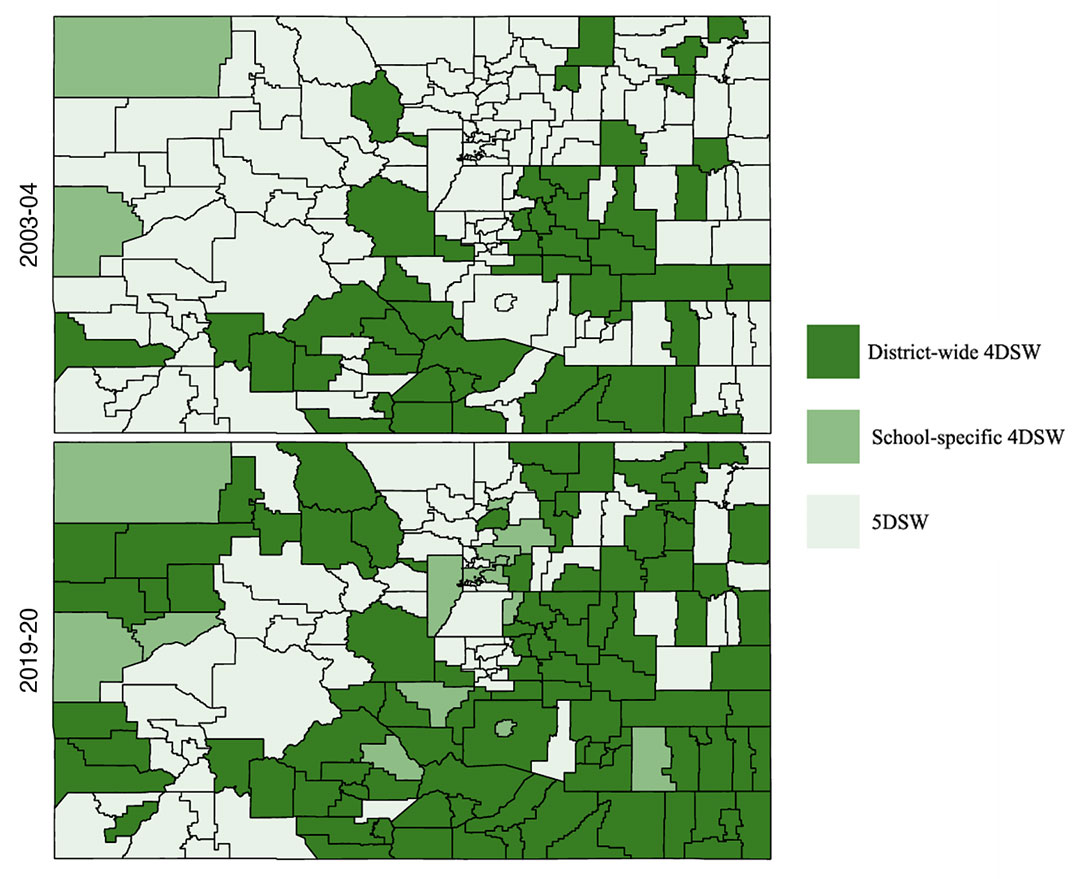Katherine M. Bowser
With education budgets under strain nationwide, a growing number of districts, especially rural districts, have adopted four-day school weeks (4DSW) in an effort to reduce costs. Between 1999 and 2019, 4DSW adoption grew by over 500%, with further acceleration in the years following the pandemic, and nearly 90% of districts with 4DSW are rural. The primary motivators for adopting a 4DSW are to (1) generate cost savings, as one fewer day of classes each week means districts can use fewer resources, leading to lower spending (2) help rural and budget-constrained districts reduce educator turnover by offering improved work-life balance
Do these new schedules really improve the staffing and budget challenges that districts face?
The study finds that adopting a four-day school week does not significantly reduce turnover for teachers, principals, or paraprofessionals, suggesting that 4DSWs might not be the staffing solution many districts hope for. The 4DSW does lead to modest, short-term financial savings (1–3% of total district expenditures), which are primarily driven by reduced food service and transportation costs. Given that other studies have found potentially harmful effects on student achievement and well-being, any financial savings from 4DSW should be carefully weighed against potential trade-offs.
THE STUDY
Colorado is one of the earliest and most widespread adopters of 4DSW policies. In 2003–04, 51 of Colorado’s 178 school districts used a four-day school week. By 2019–20, that number had more than doubled to 114 districts (a 126% increase), primarily in small, rural districts. Because districts transitioned at different times based on local decisions and circumstances, this provides a natural experiment for researchers to analyze the effects of the four-day schedule on various outcomes. Drawing on 17 years of district-level data from 2003–04 to 2019–20, the author uses a staggered event study design, an approach within the difference-in-differences framework, to examine the impact of four-day school week (4DSW) adoption on educator turnover and district finances. This approach allows for credible estimation of causal effects while accounting for district and year fixed effects. The study focuses on three staffing outcomes (teacher, principal, and paraprofessional turnover) and multiple financial metrics, including per-pupil expenditures and revenues.
Figure 1: 4DSW Adoption in Colorado. Each map shows district borders for Colorado’s 178 public school districts. The top map represents the 2003–04 academic year and the bottom map represents the 2019–20 academic year.

KEY FINDINGS
- Four-day school week adoption did not significantly affect turnover rates for teachers, principals, or paraprofessional staff, suggesting that 4DSW policies are unlikely to address staffing challenges in schools. However, this finding contrasts with some emerging studies that have found increased teacher turnover and one that found decreased turnover as a result of implementing the 4DSW. Taken together, these mixed findings suggest that the effects of 4DSW policies on educator turnover may vary by setting, highlighting the importance of studying how local conditions shape the policy’s outcomes.
- The adoption of a 4DSW was associated with small, short-term decreases in district expenditures, specifically:
- $135-$352 decrease in total support service spending per pupil. This translates to a 3-8% decrease per pupil. “Total support service spending” includes expenditures for activities that support instruction. These services include operation and maintenance of buildings, school administration, student support services (e.g., guidance counselors), student transportation, instructional staff support (e.g., librarians, instructional specialists), school district administration, business services, research, and data processing.
- $31-$40 decrease in food service expenditures per pupil. This translates to 6–9% per pupil. “Food service expenditures” include expenditures for cafeteria operations (e.g., purchase of food).
- $100-$161 decrease in total salary expenditures per pupil. This translates to 1–2% per pupil. “Total salary” covers the wages paid to all school staff directly involved with students, such as teachers, aides, counselors, health workers, and instructional support roles like librarians and curriculum coordinators. It includes both full- and part-time employees, as well as additional pay for overtime, sabbaticals, and extra duties like coaching or bus supervision.
$9 to $11 decrease in transportation salary expenditures per pupil. This translates to 3–4% per pupil. This includes salaries of permanent and temporary student transportation staff.
These financial savings are consistent with prior estimates of 1–3% average overall expenditure reductions for districts. The amount of cost savings can vary depending on factors such as whether the school building remains open on the fifth day, the size of the district, and the specific expenditures that are impacted by the four-day schedule. The actual dollar savings vary significantly depending on a district's total budget.
For example, consider a rural school district of 270 students and an annual budget of $6.3 million. Adopting a four-day school week that reduces expenditures by 1–3% would save approximately $63,000 to $190,000 per year.
- The cost savings were primarily driven by reductions in food service and transportation salaries.
- While there were short-term reductions in federal revenue in the year of adoption (11–15%), there were no long-term changes in overall revenue patterns.
IMPLICATIONS FOR POLICY AND PRACTICE
- District leaders should not expect a four-day school week to solve educator turnover issues. Instead, investing in strategies with stronger evidence for retention, such as professional learning opportunities, improved working conditions, and targeted recruitment incentives, may be more effective.
- Past research suggests that 4DSWs may be associated with negative student outcomes (health, achievement, well-being). Districts pursuing a 4DSW for cost savings should consider how to redistribute any saved funds to support student learning and mitigate potential downsides.
FULL WORKING PAPER
This report is based on the EdWorkingPaper “The Four Day Gamble: The Quasi-Experimental Effects of Four-Day School Week Adoption on Teacher, Principal, and Paraprofessional Staff Turnover and District Financial Outcomes,” published in May 2025. The full research paper can be found here: https://edworkingpapers.com/ai25-1208
The EdWorkingPapers Policy & Practice Series is designed to bridge the gap between academic research and real-world decision-making. Each installment summarizes a newly released EdWorkingPaper and highlights the most actionable insights for policymakers and education leaders. This summary was written by Christina Claiborne.